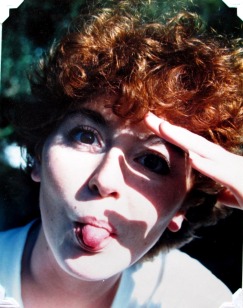The Particle Accelerator Series: When atom smashers were first invented, particle arrays were actually photographed in a machine called a bubble chamber. About the size of a school bus, it was first situated along the circumference of a particle accelerator (a miles-long, circular underground tunnel). The bubble chamber was filled with liquid hydrogen, which was then superheated and pressurized. When a liquid is superheated (brought to beyond its boiling point without actually boiling), the slightest disturbance will instantly start the liquid boiling. That’s why it’s dangerous to overheat water in a microwave. Looks innocent enough, but it explodes when you touch it. A single atom of hydrogen is sent flying around the accelerator, faster and faster until it’s traveling just under the speed of light. Then it’s directed into the prepared bubble chamber. The atom explodes into subatomic particles, which leave trails of tiny bubbles in the liquid hydrogen as they pass through. In that instant, a photograph is taken. Here‘s an example of one (it was the model for the first painting below). The higher-energy particles appear almost as straight lines; the lower-energy ones curl into tight loops and spirals. Negatively-charged particles curve to the left; positively-charged particles curve to the right. You can find these images on the net, with some work. I found them fascinating, and wanted to bring color and life to these enigmatic scenes. After waiting for the background color to dry, I traced the particle tracks with pastel pencil, and sprayed on a workable fixative. The bubbles are thousands of tiny individual beads of paint, applied with a no. 0 brush. After the beads dry (several weeks) I apply a clear gloss varnish. These paintings feel like Braille.
- Particle Accelerator 1
This is based on a micro-photograph of a moth’s wing.
A compilation of several different images of the sun.
My very first oil painting.
This is based on a micro-photograph of a butterfly’s wing.










Very nice!
LikeLike
Why, thankee! 🙂
LikeLiked by 1 person
I particularly love butterfly wing!
LikeLike
Thank you!
LikeLike
Very cool, all of them! I also really like the butterfly wing, it also looks like a big crowd of people. I like paintings like that, that could be interpreted different ways.
LikeLike
Abstract art is great that way. It can mean many different things to different people.
LikeLike
Jeez, how did I miss these? They’re gorgeous!
LikeLike
Don’t kick yourself; the page has only existed for maybe a month or two. It’s still relatively new. Thanks for looking!
LikeLike
Being an old physicist, I liked the particle track ones. In a lab once we made our own cloud chamber and you could see the tracks forming real time, by eye.
LikeLike
Wow. That must’ve been super-cool. The particle series are my favorites, too. They took many, many hours to complete. I wish I could get a better picture of the brown one, as the golden dots light up at night with a light underneath.
Let me know if you hear of any well-endowed physics departments who might be looking for some unique artwork to hang in their lobby…
LikeLike
Wow! I had no idea you were a painter too Kim. Very nice. I like the Fairie Sun and the Clouded Leopard. You are a woman of many faces ehhhh!
LikeLike
Thank you! I find a lot of inspiration just in nature and science.
LikeLike
I love your art Kim, all of it! I especially like what you are doing with the bead technique. Stunning!
LikeLike
Why, thank you so much! Let me know if you know of any well-funded physics departments who’d like one for their lobby… 🙂
LikeLike
Excellent! 🙂
LikeLike
Glad you liked!
LikeLike
I missed this too, till Three Cat Yard mentioned it today. Beautiful work all around.
LikeLike
Aw, thank you!!!
LikeLike
Kim! I can’t believe I haven’t clicked here before! These are WONDERFUL! 😀
LikeLiked by 1 person
🙂 I’m so glad you like them!
LikeLike
Well I learned something .. 🙂
Love the beads on particle accelerator 3 – and the color of course. They’re all very nice . CC
LikeLike
Awesome! Yeah, you can really see the texture of the beads on no. 3. It’s by far the smallest one.
LikeLike
You are a talent indeed. I like the butterfly one best, but they’re all wonderful. Have you tried entering them at Balboa Park’s Spanish Village where beginner’s art is shown? I’ve recommended the place to Gregg for his ceramic work. It would be a great place to get started.
I am so proud that you are my favorite daughter.
LikeLiked by 1 person
Aw, thanks, Mom. 🙂 Naw, that’s way too much trouble, showing it.
LikeLiked by 1 person
Effective. Thx.
LikeLiked by 1 person